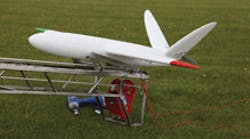A 3D printing method called laser sintering is helping to change the face of unmanned-air-vehicle (UAV) design. Engineers at the University of Southampton in the U. K. designed an entire UAV structure, including wings, control surfaces, and access hatches. The craft needs no fasteners and can be snap-fitted together without tools in minutes. Auxiliary equipment such as the electric engine also snaps on. The team worked with additive manufacturer 3T RPD Ltd. in the U. K., which built the aircraft with an EOSINT P 730 nylon laser-sintering machine from EOS GmbH in Germany.
The 3D-printed UAV has a 2-m wingspan and is almost silent in cruise mode. The aircraft also has a miniature autopilot.
Laser sintering suits UAV design because it can create shapes and structures that would normally require costly traditional manufacturing methods. The technique lets engineers develop highly tailored aircraft from concept to first flight in days.
Typically, parts take months to complete. Further, because no tooling is needed for manufacture of 3D-printed components, it’s possible to make radical changes to the craft’s shape and scale, with no extra costs.
Better yet, laser sintering lets designers revisit historical techniques and ideas that would be prohibitively expensive using traditional manufacturing. One idea involves the use of a Geodetic structure, which was used on the Vickers Wellington bomber in 1936. The structure is stiff and lightweight, but complex. To make it by conventional means would take a large number of individually tailored parts which would need to be bonded or fastened at great expense.
Another design benefit that laser sintering gives UAV is the use of an elliptically shaped wing. Aerodynamicists have known for decades that these wings offer drag benefits. For example, the Spitfire wing with its elliptical shape was recognized as an efficient design. But it was notoriously difficult and expensive to manufacture. Because laser sintering removes manufacturing constraints associated with shape complexity, there is no cost penalty to the use of elliptical wings.
